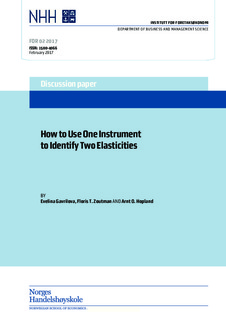| dc.contributor.author | Gavrilova, Evelina | |
| dc.contributor.author | Zoutman, Floris T. | |
| dc.contributor.author | Hopland, Arnt O. | |
| dc.date.accessioned | 2017-03-15T14:51:27Z | |
| dc.date.available | 2017-03-15T14:51:27Z | |
| dc.date.issued | 2017-02-27 | |
| dc.identifier.issn | 1500-4066 | |
| dc.identifier.uri | http://hdl.handle.net/11250/2434248 | |
| dc.description.abstract | We show that an insight from taxation theory allows identification of both the supply and demand elasticities with only one instrument. Ramsey (1928) and subsequent models of taxation assume that a tax levied on the demand side only affects demand through the price after taxation. Econometrically, we show that this assumption functions as an additional exclusion restriction. Under the Ramsey Exclusion Restriction (RER) a tax reform can serve to simultaneously identify elasticities of supply and demand. We develop a TSLS estimator for both elasticities, a test to assess instrument strength and a test for the RER. Our result extends to a supply-demand system with J goods, and a setting with supply-side or non-linear taxes. Further, we show that key results in the sufficient statistics literature rely on the RER. One example is Harberger’s formula for the excess burden of a tax. We apply our method to the Norwegian labor market. | nb_NO |
| dc.language.iso | eng | nb_NO |
| dc.publisher | FOR | nb_NO |
| dc.relation.ispartofseries | Discussion paper;2/17 | |
| dc.subject | Tax Reform | nb_NO |
| dc.subject | Instrumental Variable | nb_NO |
| dc.subject | Supply and Demand Elasticities | nb_NO |
| dc.subject | Tax Incidence | nb_NO |
| dc.subject | Payroll Taxation | nb_NO |
| dc.title | How to Use One Instrument to Identify Two Elasticities | nb_NO |
| dc.type | Working paper | nb_NO |
| dc.source.pagenumber | 26 | nb_NO |
